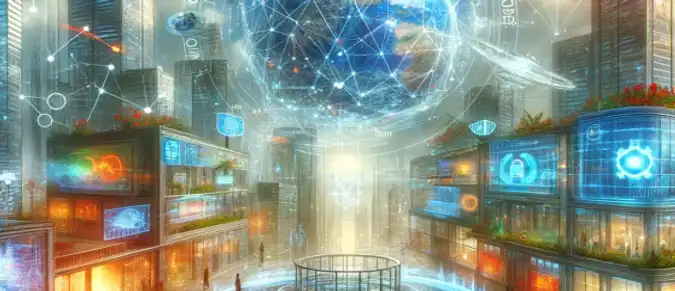Recently, there has been an increasing discussion about the need to update the existing concept of the Internet. This stems from the aggressive data collection by many corporations, their control over information, and possessing more data about individuals than their own families. In response, influential figures and key industry players have proposed various ideas for the development of Web 3.0, aiming to enhance and secure the Internet further.
Furthermore, it's important to understand that the concepts of Web 2.0 and 3.0 are conditional and were formed under the influence of certain authoritative figures. History shows that these ideas often emerged from analyzing various web services and sites in terms of their technological content.
- Overview of Web 2.0 Technology
- Characteristics of Web 3.0
- Comparison of Web 2.0 and Web 3.0 Applications

Overview of Web 2.0 Technology
In 2005, Tim O'Reilly, an American publicist and advocate for open-source software, published an article outlining Web 2.0. In his material, he pointed to the growing number of sites unified by common ideas and principles.
It is believed that the era of Web 2.0 began in 2004 and continues to this day. During this period, large companies took control of the Internet, building online empires, while users gained the opportunity to actively participate in content creation. Web 2.0 operates on the principle of "read/write" on the Net.
Widespread authorization on the Internet appeared, and users began to voluntarily provide their data in exchange for the convenience of using resources. Companies started to generate revenue from this data, selling it to advertisers, and some launched their own advertising platforms, centralizing profits.
In Web 2.0, social functions also developed, allowing users to interact, exchange messages, and make calls. The possibility of personalizing profiles, publishing photos, entries, videos, and articles appeared, as well as receiving feedback and likes from other users. Sites introduced rating systems, such as karma or reputation.
In the era of Web 2.0, recommendation algorithms, aimed at retaining user attention, started to play a significant role. These algorithms take into account many factors and work almost everywhere, from social networks to marketplaces. Thus, the content, for example, on the main page of YouTube, will differ for different users.
With the growing popularity of social networks and the large volume of content, companies began to pay more attention to the information published, introducing strict rules and content moderation.
Characteristics of Web 3.0
Jason Calacanis, head of Netscape, was one of the first to outline the key ideas of Web 3.0. It should be noted that, as before, the precise understanding of the future development of the Internet remains uncertain. At the moment, Web 3.0 is at an early stage of development, with only a general idea of its directions. Calacanis expressed his vision of the future of the Internet as early as 2007, emphasizing the need to create a new space based on Web 2.0 to solve its main problems.
According to Calacanis, the main problem lies in the unification of resources and services due to the relative ease of creating websites. Tim O'Reilly also supported these ideas, adding that Web 3.0 should go beyond the usual perception of the Internet and start interacting with the physical world.
Key characteristics of Web 3.0 include:
- Decentralization: data will be distributed among users, rather than stored on centralized servers. Computations will move from data centers to personal devices of users.
- Artificial Intelligence and Machine Learning: will continue to assist in content search and create more transparent services.
- Openness: software will be open-source, providing a deep understanding of how tools work.
- Freedom: a reduction in Internet censorship is expected, with the community taking over the role of moderation.
- Ubiquity: the Internet will be everywhere thanks to IoT devices and smart gadgets.
- Semantic Web: improving the understanding of natural language queries.
Additionally, there may be changes in the authorization system to a unified platform that combines various services. Also, the democratization of the Internet is anticipated, with the usefulness of content being determined by Decentralized Autonomous Organizations (DAOs).
However, currently, the ideas of Web 3.0 remain mostly theoretical and are often discussed by crypto investors and NFT enthusiasts, focused on new ways of earning.
Comparison of Web 2.0 and Web 3.0 Applications

In a world where digital technologies are evolving at an incredible pace, understanding the evolution of internet applications from Web 2.0 to Web 3.0 becomes key to grasping current and future trends in the digital space. Web 2.0, symbolizing the era of social networks, blogs, and wikis, opened the door for active user participation in content creation. With the advent of Web 3.0, we have witnessed a revolution in the field of decentralization, blockchain usage, and artificial intelligence, leading to the emergence of new, more complex, and secure applications.
| Examples of Web 2.0 | Examples of Web 3.0 |
|---|---|
| Social networks and media sites (e.g., Facebook, YouTube, Flickr) | Decentralized Applications (DApps) on the blockchain |
| Blogs and wikis (e.g., Blogger, Tumblr, LiveJournal, Wikipedia) | Smart Contracts on blockchain platforms |
| Folksonomies (keyword "tagging" systems) | Blockchain technologies and cryptocurrencies (e.g., Ethereum) |
| Video and image sharing services (e.g., YouTube, Flickr) | Advanced artificial intelligence and machine learning systems |
| Hosting services and web applications | Internet of Things (IoT): network-connected devices and applications |
Overall, the transition from Web 2.0 to Web 3.0 represents a shift from centralized, company-controlled systems to more decentralized, user-managed networks, leading to greater security, privacy, and data sovereignty.




